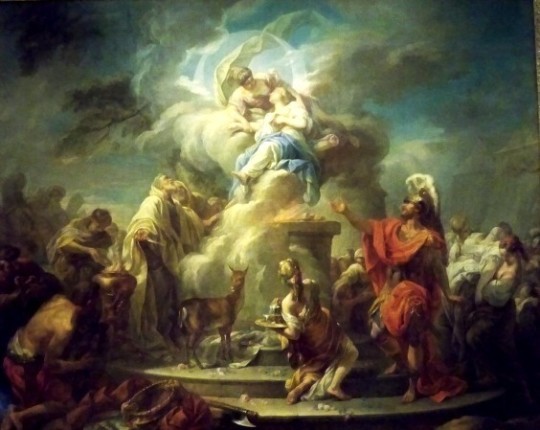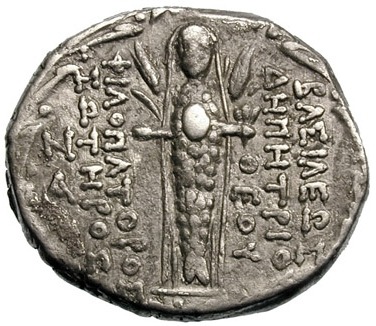This is something I think we could all enjoy.
You have no idea what the moon phase is
You have no idea if it is retrograde or life is just fucking with you
You haven’t attempted a spell in months
Magic probably could have helped you cope with some of the things you dealt with in the last few months
It’s been months since you opened a book on magic/witchcraft
It’s okay… it happens. Sometimes life just hits us from all directions. There’s no pressure to be a super witch.
Install a phase app on your phone that has a widget for the home screen
Try to incorporate mini spells, little magics with your coffee cup in the morning…stir it clockwise with your intention or draw sigils with your spoon/stirrer
Who cares if it is retrograde or not… if life is hitting you from all sides, take precautions like it is.
Remember you are not required to open a book on the craft every week, or even every month. You’re not always ready to start learning new things and absorbing new knowledge. Relax.
“polytheism uncucked” oh my god please i cannot contain the fucking cringe this name contains
not to mention: sorry kenaz filan, i’ll call out racists if i see them, polytheists or no. no one says “beautiful white babies” without saying it in a racist context, because they believe in blood purity, eugenics, and only non-interracial relationships.
Guess who started a Patreon!
If you don’t know what Patreon is, it’s a site that allows you to support your favorite artists, musicians, or even podcasts and youtube channels with a monthly (or by creation, I chose monthly) payment. With the money you spend, you can get rewards like thank yous and discounts, special access to sketches and artwork that won’t be released to the public, as well as just knowing you’ve helped out your fave artists! I’ll be updating the page with a new banner and other stuff soon, but for now take a gander and maybe help me out if you can
Melodie Renee is creating digital drawings, charcoal and pastel drawings | Patreon
Propolos: Guide, companion, servant. Sophocles, The Root Cutters. The Homeric Hymn to Demeter.
In the LSJ Propolos suggests “going,” or “acting before,”
and was usually applied to servants, attendants and those who minister to
another. Those who serve a God, or who interprets the Gods’ will to men are
also sometimes known as Propolos.
Jacqueline Feather, who admittedly approaches Hekate from a
more psychological angle, suggests that Hekate is Propolos when guiding the
Gods, and Phosphoros when guiding mortals. But there is naught to suggest that
this has a historic background.

Propolos can also mean ‘handmaiden,’ and Hekate’s role in
the Hymn to Demeter directly notes that She becomes the handmaiden of
Persephone. It is Hekate who sometimes guides Persephone into (and out of) the
Underworld. She also serves a similar purpose for the Dead themselves. It is
from this position that Hekate became the Mistress of Ghosts and Leader of the
Restless Dead. I have not had the chance to read the original Greek, but I
wonder if Sappho’s poem about Hekate being the attendant to Aphrodite describes
her as Propolos.
Iphigeneia, who is, according to some stories, also Hekate,
is the propolos of Artemis. The story goes that Iphigeneia, daughter of
Agamemnon, was offered as sacrifice to the Gods, because the Gods were holding
the King’s fleet from sailing for Troy. She was rescued by Artemis, and thereby
became her companion.
Hermes too is Propolos to Zeus. He regularly attends to the
King of the Gods, or serves as his messenger. We see them together in several
stories, perhaps most popularly the story of Deucalion and Pyrrha. He could
also attend on a few different Goddesses, alongside Pan.
But Priests could also be Propolos, though we are uncertain
of the specifics of their position and responsibilities. The title varied from
cult to cult, and usually the God’s attendant was expected to be the same
gender as the deity (which notable exceptions in the cultus of Cybele and
others.) Each cult had its specific responsibilities, which varied considerably
depending upon the polis and the variations of interpretations of the Gods.

I have encountered a lot of Hekatean practitioners who are
uncomfortable with the idea of Hekate being the handmaiden or attendant or
companion to anyone. They see her as the indomitable Queen of the Underworld.
And that’s cool. But I would argue that Queens (and Kings) are best understood
in terms not of their domination of others, as they are truly servants to the
responsibilities of their position. There is no degradation in service. I am
not made less by my helping others nor am I weakened by doing service to
another. Kings and Queens serve the good of their domains, and if they do not,
then they are not worthy of the throne. Hekate Propolos is not diminished by
her service to the other Gods, nor is Hermes, rather they are empowered and
magnified by their companionship with them!
Sources:
Lsj.translatum.gr
theoi.com
Feather, Jacqueline. Hekate’s
Hordes: Memoir’s Voice, Pacifica Graduate Institute, 2009.
Harrison, Jane Ellen. Themis: A Study of
the Social Origins of Greek Religion, Cambride, 2010.
Johnston, Sarah Iles. Restless Dead:
Encounters between the Living and the Dead in Ancient Greece, Univ.
California, 2013.
Mikalson, Jon D. Ancient Greek Religion,
Wiley & Sons, 2009.
Ogden, Daniel. A Companion to Greek
Religion, Wiley & Sons, 2010.
Peck, Elisabeth Sinclair. A Study of the Greek Priestess, Univ.
Michigan, 1916.
Images:
Doyen, Gabriel Francois. “The Sacrifice of Iphigeneia,” oil
painting, 18th c. CE, now in the Maison Motais de Narbonne, via
wikicommons: https://commons.wikimedia.org/wiki/File:Doyen_-_Le_sacrifice_d%E2%80%99Iphig%C3%A9nie.jpg
Smith, William. “Persephone (Proserpine) Enthroned,” from A Smaller Classical Mythology: with
translations from the Ancient Poets, and Questions Upon the Work, John
Murray, 1882. Wood-engraving, 1882. Via wikicommons: https://commons.wikimedia.org/wiki/File:Persephone_enthroned_(Illustrated_by_Engravings_on_Wood).jpg
So was Venus born of the sea with this little kernel of salty honey in her, which only caresses could bring out of the hidden recesses of her body.

Goddess of love, beauty, pleasure, and desire. First of a series on Greek gods and goddesses!
(Scythian)
In the Bosphorus, Argimpasa was identified with Aphrodite
Ourania. This Scythian Goddess bears the traits of a native Great Goddess, and
seems to have heavily influenced how the Greeks at Apatourum understood the
Golden Goddess of Love.
Herodotus saw the connections between the two, and tells us
that there were oracles who worked for Aphrodite called the Enareis, who seem
to have been trans*persons, though it is tricky to apply our modern understanding
of what that means to such a different society.

Unlike the Greek Aphrodite, Argimpasa is closely associated
with the dead, and has many images buried in graves. She is associated with a
fish-woman, Derceto, who, it was said offended Aphrodite, and killed herself in
a deep lake in Ascalon. In so doing, she was turned into a fish, with the head
of a woman. Derceto herself is sometimes
known as Derceto-Atargatis, suggesting that She is a Goddess in Her own right.
Argimpasa is seen dancing with Satyrs and Maenads,
celebrating orgiastic rites.
All that said, Argimpasa differs from Aphrodite in
significant ways. She is a vegetal-fertility goddess with a distinct chthonic
streak. Some of the images associated with the cult have her in a semi-bestial
state, with two tentacle or serpentine legs (coins and gems from the ancient
world often show Abraxas with the same feature.) She is winged, and rides lions
and griffins. She is associated with funerals.
She is the Goddess of Love (thus Her association with
Aphrodite) and War, Death, and Destruction. She is also a Mistress of Animals,
something also shared with Aphrodite.
Argimpasa is also crueler and more violent in her character,
than Aphrodite (who, in spite of her association with Ares, ran home to her
mother in the Iliad when she was hurt in battle).
Argimpasa shares many traits also with Anahita and Astarte.
She is a mistress of the celestial waters, and rules sovereignity, fecundity,
and is generally multi-functional. She was served by eunuch priests from the
highest class families and even was the patron of royalty.

Many of the surviving images of Argimpasa-Aphrodite display
an enthroned Goddess with a man facing her. She is often robed and veiled,
sometimes holding a mirror or a small vessel. Her image seems to be a popular
choice for diadems and headdresses in gold.
Ultimately, it seems that Argimpasa is a Goddess spanning
both heaven and earth, life and death. She brings love, and pain. For the
Scythians, who were one of the people that the Greeks understood to be Amazons,
She encompassed many things, and came with them into the afterlife. A truly
vast Goddess, as broad and powerful as the plains which carried Her people.
Sources:
Jacobsen, Esther. The
Art of the Scythians: the Interpenetration of Cultures at the Edge of the
Hellenic World, Brill, 1995.
Shenkar, Michael. Intangible
Spirits and Graven Images: the Iconography of Deities in the Pre-Islamic
Iranian World. Brill, 2014.
Ustinova, Yulia. “Aphrodite Ourania of the Bosphorus: The
Great Goddess of a Frontier Pantheon,” in Kernos 11, 1998. p.209-226
——————. The
Supreme Gods of the Bosporan Kingdom: Celestial Aphrodite and the Most High
God, Brill, 1999.
Images:
Unknown, “Golden Deer,” Scythian, 6th c. BCE, now
in the Hungarian National Museum in Budapest. Photo by Yelkrokoyade, 2011. Via
wikicommons: https://commons.wikimedia.org/wiki/File:Cerf_d%27or_Scythe.jpg
“Silver Demetrius, with Derceto from Ascalon,” photo by Yak,
2007. Via wikicommons: https://commons.wikimedia.org/wiki/File:Derketo.jpg
